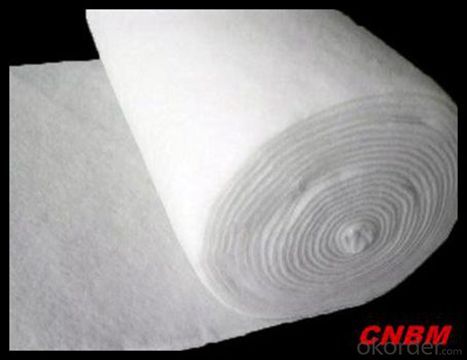Geotextile Fabric Vancouver Wa - High Quality Polypropylene Nonwoven Fabric Geotextile for Construction
- Loading Port:
- China main port
- Payment Terms:
- TT OR LC
- Min Order Qty:
- 3000 m²
- Supply Capability:
- 1000000 m²/month
OKorder Service Pledge
OKorder Financial Service
You Might Also Like
Specification
Product Introduction
Material: bean nylon polyester/ Non-woven flower
Pore diameter (mm) : 0.15
The runoff rate: 320
Tensile strength (N) : 160
Hydraulic flow (L/S), tongji university laboratory tests
Head loss 5 cm: 2.4
Head loss 10 cm: 3.2




Packaging & Shipping
Packing: PLASTIC FILM INSIDE, AND WOVEN BAG OUTSIDE
Shipping: About 15 days after receipt the deposit
geotextile fabric
permeability,filtration,easy for construction
ISO and CE certificate
Good quality and competitive price
After-sales service
1.In order to provide customers with comprehensive technical support,we will provide technical and other related information upon request in a timely manner.
2.In required,we will appoint specialized technicians to the construction site to give technical trainings to construction people,and offer technical guidance throughout the whole construction process.
3.For damage due to shipment and delivery,after we receive the complaint,we will check the issure through provided pictures and videos.If our responsibility is confirmed,we wil offer free replacement.
4.When the construction is completed,as your request,our technical staff may participate in the final acceptance.
FAQ:
Q: What kind of payments does jenor support?
A: T/T, L/C, Cash are accepted.
Q: Do you charge for the samples?
A: Accordeing to our company policy, the samples are free, we only charge the freight fee. And we will return the freight fee during the next order.
Q: Can you produce according to customers' design?
A: Sure, we are professional manufacturer, OEM and ODM are both welcome.
Q: Do you have other products?
A: Yes, please check the pictures:
- Q: Concrete panel shop asphalt do not add geotextiles
- Plus no geotextile cloth according to the design requirements and construction specifications. Generally require high road construction need to lay geotextile. Geotextile manufacturers to answer your questions
- Q: What are the different geotextile installation techniques for roadways?
- There are several geotextile installation techniques for roadways, including overlay installation, trench installation, and full-depth installation. Overlay installation involves placing the geotextile on top of the existing road surface before applying a new layer of asphalt or other material. Trench installation involves placing the geotextile in a trench dug along the road's edge and backfilling it with soil or aggregate. Full-depth installation involves placing the geotextile directly beneath the entire road structure, providing reinforcement and separation between the subgrade and the overlying layers. The choice of technique depends on the specific road construction requirements and the desired benefits of using geotextiles.
- Q: How do geotextiles help with erosion control on slopes?
- Geotextiles provide erosion control on slopes by acting as a barrier that prevents soil erosion caused by wind and water. These textiles are permeable, allowing water to pass through while trapping soil particles, thereby stabilizing the slope and preventing erosion. Additionally, geotextiles enhance vegetation growth by retaining moisture and providing a protective layer, further reducing erosion on slopes.
- Q: How to overcome the problems of impervious geotextile?
- Geotextile is a filter and protection function, itself is permeable. The main material of impermeable material is geomembrane.
- Q: Polyester non-woven and geotextile is not the same, what is the difference?
- Polyester non-woven fabric is made of polyester non-woven fabrics, refers to the use of raw materials and geotextile is made of non-woven fabrics, is a non-woven use.
- Q: Can geotextiles be used in pond liner applications?
- Yes, geotextiles can be used in pond liner applications. They are often used as a protective layer or as a separator between the soil and the pond liner material. Geotextiles can help prevent punctures or damage to the liner, enhance its durability, and improve overall performance of the pond liner system.
- Q: Composite geotextile per square meter of labor costs how much money 'sewage treatment pool' ground plane 'square meters. More
- Hello, the labor costs are calculated by the day, geotextile composite film to see what you need specifications, according to per square meter, the weight is not the same, the price is not the same
- Q: What are the key considerations for geotextile installation in seismic retrofitting projects?
- The key considerations for geotextile installation in seismic retrofitting projects include the selection of appropriate geotextile materials that can withstand high seismic forces, ensuring proper installation techniques to prevent slippage or failure during an earthquake, and considering the compatibility of geotextiles with other retrofitting techniques to provide a comprehensive and effective seismic upgrade. Additionally, factors like site-specific conditions, design requirements, and regulatory guidelines must be taken into account for successful geotextile installation in seismic retrofitting projects.
- Q: Road overhaul of the original concrete pavement after shaving asphalt, anti-cracking is geotextile or geogrid more
- To see the specific situation, the general use of grille, I am specializing in the production of geotechnical materials
- Q: What are the different factors to consider for geotextile selection in landfill applications?
- There are several factors to consider when selecting geotextiles for landfill applications. These include the type and composition of waste being disposed of, potential chemical interactions, required strength and durability, permeability and filtration requirements, and compliance with regulatory standards. Other factors such as installation and maintenance costs, availability, and environmental sustainability also play a role in geotextile selection for landfill applications.
Send your message to us
Geotextile Fabric Vancouver Wa - High Quality Polypropylene Nonwoven Fabric Geotextile for Construction
- Loading Port:
- China main port
- Payment Terms:
- TT OR LC
- Min Order Qty:
- 3000 m²
- Supply Capability:
- 1000000 m²/month
OKorder Service Pledge
OKorder Financial Service
Similar products
Hot products
Hot Searches
Related keywords






























